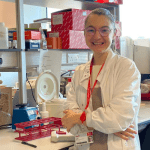Testing the in vivo efficacy of base and prime editing in primary fibroblasts and in a 3D skin model of dystrophic epidermolysis bullosa
Lay summary
All forms of dystrophic epidermolysis bullosa (DEB) result from faults (mutations) in the Collagen VII gene (COL7A1). These mutations alter the Collagen VII in the skin which normally makes adhesion structures called anchoring fibrils that hold the outer layer (epidermis) and inner layer (dermis) together to prevent blistering. Previous research studies and clinical trials have attempted to fix the COL7A1 mutations by replacing the entire COL7A1 gene, but this form of gene therapy has had limited clinical benefits.
This research uses the newest form of gene editing (base editing and prime editing), allowing correction of the COL7A1 mutations in a more focused manner, somewhat like fixing typos in a word document by cutting and pasting correct text directly over the error. This research looks to develop this type of gene editing for COL7A1 mutations as future new therapies for DEB.
The initial work will be carried out in skin cells donated by patients with different forms of DEB. This step is to test the efficacy of the chosen gene editing reagents in restoring the COL7A1 gene and Collagen VII, as well as the safety of the approach (i.e. no collateral damage to other genes). This work will be carried out in skin cells donated by people with different forms of DEB.
The project will also test different methods of delivering the gene editing tools into the cells, using lipid ‘bubbles’ that can penetrate various cells, including skin cells. Finally, the project will address how these optimized gene editing tools can be delivered directly into the skin – using skin equivalents (laboratory models of 3D skin).
The aim of the project is to bring this kind of treatment to clinical trials in DEB.
Extension granted in October 2023: Over the first 12 months of the current grant, we have made very considerable progress in testing base editing with lipid nanoparticle delivery. The editing is as efficient as it was with electroporation or commercial non-human lipid reagents. Notably, correction is almost 100% which represents a breakthrough in the field. Our current activity involves testing penetration through human skin using human skin equivalents obtained from a commercial company. However, we also need to test delivery of this system in an DEB animal model. Establishing new animal data will be an important step towards bringing our novel DEB gene therapy into the clinic.
Extension granted in October 2024: We will conduct a series of safety experiments for base and prime editing at the genome level.
Scientific Summary
This gene editing research focuses on developing base and prime editors as potential therapies for DEB. mRNA strategies do not pose the same risk of insertional mutagenesis associated with viral or plasmid-based systems and the controllable dosing and transient expression of the mRNA reduces off-target editing, enhancing the safety of any future therapy.
Targeting specific COL7A1 mutations, the work examines efficacy, safety, delivery, and functional correction in cells and 3D skin models, as key pre-clinical steps to future clinical application. Base editor and prime editor mRNAs will be electroporated into primary DEB cells and high-throughput sequencing will assess on-target and off-target loci, with Collagen VII levels assessed by Western blotting. In DEB skin equivalents, different formulations of lipid nanoparticles will be used for in vivo delivery, evaluating Collagen VII by immunohistochemistry and anchoring fibrils by electron microscopy.
Extension granted in October 2023: After highly efficient correction of a COL7A1 pathogenic variant in RDEB patient fibroblasts using lipid nanoparticles, we will target the equivalent single nucleotide variant in a recently published DEB disease model. We will test different delivery routes of lipid nanoparticles, in vivo targeting efficiency of epidermal and dermal cells, and the long-term therapeutic implications for skin homeostasis and repair. These essential preclinical data will enable us to further develop the clinical translation of our novel gene therapy approach.
Extension granted in October 2024: We will conduct a series of safety experiments for base and prime editing at the genome level, including whole genome, amplicon and RNA sequencing analysis.
Publications
Lipid Nanoparticles Efficiently Deliver the Base Editor ABE8e for COL7A1 Correction in Dystrophic Epidermolysis Bullosa Fibroblasts In Vitro J Invest Dermatol. 2024; 144: 2314-2317


